Americans are notoriously uncomfortable with death, passing on the processing, display, and final disposition of our loved ones to professionals to the tune of $16.3 billion annually in 2012. Maybe it’s the finality of death that conflicts with the American ethos of endless second chances and reinvention – you can’t put the past behind and start over again if you’re dead. And in a society that prides itself on ever youthful vigor and energy, the limp finality of death is an inconvenient reminder that youth, vigor, and even life itself have an expiration date, and who needs that kind of distraction?
So death is hands-off in America, but that is emphatically not the case elsewhere — from Asia to Latin America, from the Chinese Hungry Ghost Festival to the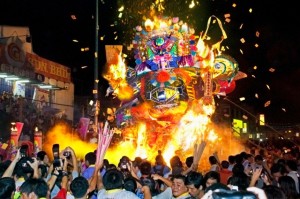 Mexican Day of the Dead — where the dead are never far away and can intervene for good or ill on behalf of the living.
Mexican Day of the Dead — where the dead are never far away and can intervene for good or ill on behalf of the living.
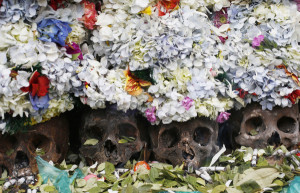 Take Bolivia, where the annual Day of the Skulls is held on November 8, one week after All Saints Day. In what for us is a garish and ghoulish display of familiarity with the dead, the skulls of the dear departed, rather jauntily called “natitas” (“snub-nosed”), are adorned with flowers, especially the nardos, a curative plant with white, fragrant blossoms; and personal articles like hats and sunglasses. The skulls are offered food, drink, cigarettes, and coca leaves; and are paraded around on ceremonial cushions.
Take Bolivia, where the annual Day of the Skulls is held on November 8, one week after All Saints Day. In what for us is a garish and ghoulish display of familiarity with the dead, the skulls of the dear departed, rather jauntily called “natitas” (“snub-nosed”), are adorned with flowers, especially the nardos, a curative plant with white, fragrant blossoms; and personal articles like hats and sunglasses. The skulls are offered food, drink, cigarettes, and coca leaves; and are paraded around on ceremonial cushions.
Many also have cotton balls inserted into eye and nose holes, perhaps so they seem less, well, vacated.
“We celebrate [the dead] because they give us many miracles. They take care of us, they protect us, the people who are devoted to them,” celebrant Leticia Plaza told Reuters. Celebrants dress colorfully and dance to heighten the festivity. “We dance with devotion and gratitude for all they give us. They have fulfilled many desires. And that’s why we honor them,” said Rosmery Aquino. The tradition’s roots can be traced to indigenous Andean ancestor worship, and in particular the Urus Chipaya custom of disinterring the corpses of loved ones at the one year anniversary of their death.
The dead fulfilling desires and actively watching over the living is a very gray area for the Roman Catholic Church, so All Skulls Day is not officially recognized, 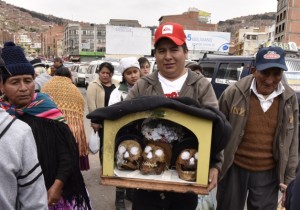 but churches are open for blessing ceremonies because it’s unwise to piss off people with decorated skulls, looking for a party. Twelve years ago when the Cementerio General chapel in La Paz refused to open for All Skulls Day blessin
but churches are open for blessing ceremonies because it’s unwise to piss off people with decorated skulls, looking for a party. Twelve years ago when the Cementerio General chapel in La Paz refused to open for All Skulls Day blessin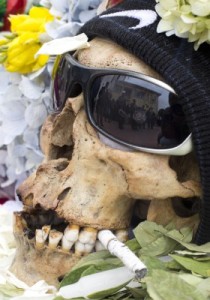 gs, disgruntled locals pelted the church with rocks and broke all the windows.
gs, disgruntled locals pelted the church with rocks and broke all the windows.
Thoughtfully, it is not only the skulls of family members that are honored. “They are the forgotten souls, they are the souls that don’t have flowers. Every November 8, we remove them from their tomb so that we can be with them and share this celebration with them,” explained Patricia Llave.
To be dead and lonely is just too much for any soul to bear, it would seem.
Why these souls are hanging around and not in heaven or hell is a little fuzzy and not exactly kosher per the Church, but maybe there’s some doctrinal wiggle room in purgatory. The indigenous belief held that a person had seven souls and one of those souls remained in the skull – it was only reasonable to show them a good time and get them some fresh air once a year.
Imagine this celebration in the U.S., where living participants would be arrested for grave robbery and abuse of corpses, insurance companies would decry the health risk, pundits would rail against the unseemliness of such a display, and the Church would have a collective heart attack.
(Images Juan Karita/Associated Press)


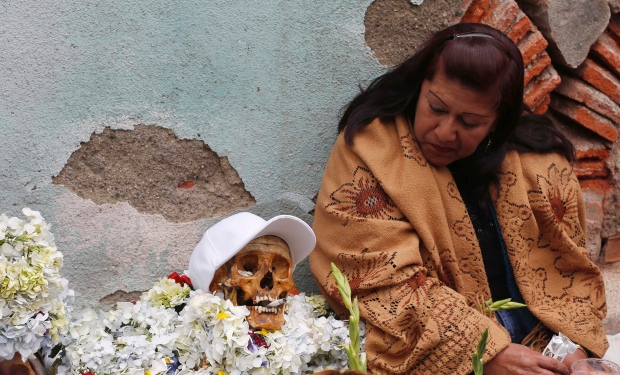






Share This
Share this post with your friends!